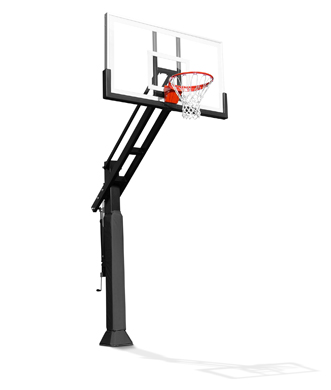| Backboard | 60"Regulation 1/2" thick glass |
|---|---|
| Adjustment | Anywhere between 5' and 10'Industry's lowest |
| Pole | 6" x 6"One piece 5ga thick steel, industry's thickest |
| Rim | Dual Spring Break-Away25lbs alone, made for dunking |
| Pole | |
| Pole Size | 6" x 6" with 7/32" (5 gauge) thickness |
| Steel Type | Structural (mild) carbon steel with .29% carbon and a density of 7.85 g/cm3 |
| Pole / Gusset Padding | Included. Custom fitted weather resistant vinyl covering with 1" thick high-impact padding |
| Flanged Base | 11.8" x 11.8" x ½" self-leveling |
| Flanged Base Holes | Oblong allowing you to square by twisting |
| Gussets | 8 of them each 3/8" thick |
| Backboard | |
| Backboard Size | 60" x 36" x 1/2" |
| Backboard Material | Tempered Glass |
| Backboard Frame Size | 2" with ¼" thickness |
| Backboard Frame Material | Aluminum with steel reinforcement |
| Glass To Frame Mounting | Mechanically encased in channel with rubber gasket |
| Rim Mounting Type | Through glass using grommets. No pressure on glass. |
| Backboard Padding | Included. Custom fitted weather resistant polyurethane-skinned 1" thick high-impact padding with molded steel inserts for mounting. Pre-installed. |
| Extension Arms | |
| Overhang | 4' (front of pole to front of backboard) |
| Main Extension Arm | 3" x 2" with 1/8" (11 gauge) thickness. Has two cross members |
| Upper Parallel Linkages | 1 ½ x ½" with 1/8" (11 gauge) thickness |
| Height Adjustment | |
| Adjustable From | Anywhere between 5' and 10' |
| Adjustment handle height from base | 2' |
| Lift Assist Cartridges | 1 cartridge, 2 springs |
| Lift Assist Power | 100 pound-force per square inch (PSI) |
| Shipping | |
| Service | Included* LTL freight curb-side delivery |
| Lift-Gate | Included |
| Scheduled Delivery | Included |
| Residential Delivery | Included |
| Weight | 500 lbs. |
| Shipping Weight | 560 lbs. |
| Packaging Configuration | 4 cartons on 1 pallet |
| Fasteners (nuts bolts & washers) | |
| Material (Standard Version) | Structural (mild) carbon steel with .29% carbon and a density of 7.85 g/cm3 |
| Material (Rust Armor Version) | Stainless steel with UNS Designation of S20100 |
| Rust Armor Version | |
| Available | Yes |
| Structural Treatment | Hot Dip Galvanization |
| Fastener Material | Stainless steel with UNS Designation of S20100 |
| Warranty | Extended. Covers corrosion damage as long you own the system |
| Anchor and Pier | |
| J-Bolt Count | 4 |
| J-Bolt Size | 5/8" diameter 18" long |
| J-Bolt Material | Ultra-high carbon steel with zinc galvanization |
| Warranty | |
| Limited Lifetime Warranty | Yes |
| Covers Dunking & Hanging | Yes |
Installation Directions
Installation Video Pier Assembly
Resources Center
























